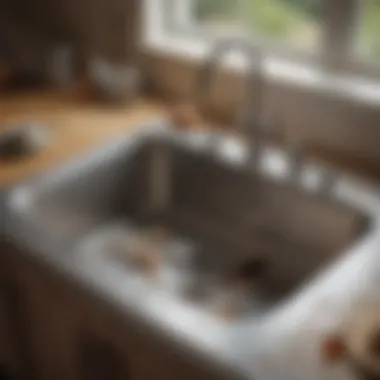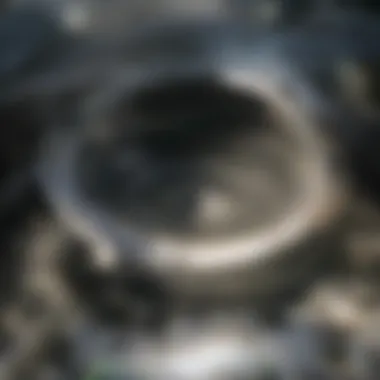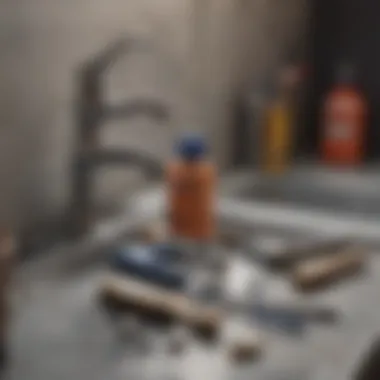Understanding and Addressing Sink Problems in Drains


Intro
Understanding sink problems in drains is vital for effective plumbing maintenance. Homeowners and property managers often face various issues that stem from hidden complexities in drainage systems. These problems can lead to slow drainage, unpleasant odors, and even structural damage in severe cases. Being informed about causes and solutions can save time and money.
Proper maintenance of sinks goes beyond occasional cleaning. It is about integrating practices that can enhance the overall plumbing system efficiency. Additionally, being aware of common misconceptions is important. Some property owners believe that certain products can provide an instant fix. This is often misleading. The article will delve into specific sink issues, analyze components involved, and discuss practical solutions available for both residential and commercial settings.
By fostering an understanding of these problems, readers can take steps toward prevention and timely intervention. This proactive approach is essential not only for preserving the functionality of sinks and drains but also for maintaining a healthy living environment.
Preamble to Sink Problems
The topic of sink problems, particularly in relation to drainage systems, is significant for anyone who utilizes plumbing. Understanding these issues can directly influence homeowner satisfaction and overall property value. Often, sink problems emerge subtly and can escalate into larger complications if not addressed promptly. This article aims to shed light on the dynamics involved in sink drainage issues, what causes them, their impacts, and how to effectively tackle these obstacles.
Defining Common Sink Issues
Common sink issues include slow drainage, unpleasant odors, gurgling noises, and water backflow. Each of these problems can be symptomatic of larger plumbing malfunctions or maintenance oversights. Slow drainage signals possible blockages, often caused by debris accumulation. Foul odors usually stem from stagnant water or malfunctioning traps, which may compromise hygiene. Gurgling sounds can indicate air trapped in the plumbing system or faulty venting. Finally, water backflow is often a serious concern as it can lead to contamination and structural damage.
Impact on Daily Functionality
The functionality of sinks has a vast impact on daily life. When sink drainage fails, tasks like washing dishes or personal hygiene become challenging and frustrating. Consider the average household where multiple sinks are in use daily—kitchen sinks must drain effectively for meal preparation, while bathroom sinks require swift drainage for hygiene routines.
Failure to maintain functional drainage can lead to inconveniences, increased repair costs, and even contribute to less efficient water use. Furthermore, sink and drain problems can affect resale value if they indicate neglect in proper home maintenance.
"Addressing sink problems promptly not only preserves daily functionality but also protects the property value in the long run."
Ultimately, recognizing and addressing sink problems is key to ensuring not only personal convenience but also long-term financial sense.
Common Causes of Drain Issues
Understanding common causes of drain issues is essential for both homeowners and property managers. This section provides insights into factors contributing to sink problems, enabling effective remedies and preventative measures. Recognizing these causes can save time, money, and hassle in the long run. By addressing the root elements, one can enhance drainage functionality and prevent future issues.
Clogs and Blockages
Clogs and blockages are prevalent problems in sinks, often arising from the accumulation of debris, grease, hair, and soap residue. As these materials build up, they restrict water flow, leading to slow drainage or complete blockages. One common contributor is the use of synthetic products, which may not dissolve easily.
To prevent clogs, regular maintenance is crucial. Techniques such as using screens over drains can catch debris before it enters the piping system. Additionally, flushing drains with hot water can help eliminate grease accumulation. Removing visible debris on a weekly basis may also prove beneficial.
Faulty Installation
Faulty installation can lead to persistent drainage troubles. This issue often manifests when pipes are improperly aligned, creating dips that collect water. In some cases, inadequate sealing of joints may allow leaks to occur, further complicating plumbing systems.
To avoid such issues, it is important to hire qualified professionals for installations. They should follow local building codes and regulations to ensure proper drainage. Homeowners can also conduct periodic inspections of visible pipes for any signs of misalignment or leakage.
Aging Infrastructure
Aging infrastructures can significantly contribute to drainage issues. Over time, pipes wear down, corrode, or become occluded, reducing their effectiveness. Older systems may not handle modern water usage levels, resulting in frequent problems.
Regular assessments of plumbing infrastructure are essential. Homeowners should be aware of their property’s age and the potential need for upgrades. Investing in high-quality materials and modern techniques can mitigate risks associated with aging pipes.
External Factors
External factors also play a vital role in causing drain issues. Environmental elements such as tree roots, heavy rainfall, and local geological conditions can adversely affect drainage systems. Roots can infiltrate pipes, leading to significant blockages. Similarly, flooding can overwhelm drainage capacity.
To counter these challenges, property owners should implement landscaping strategies that minimize root intrusion, such as maintaining appropriate distances between trees and drainage lines. Diversions like trenches or French drains can also help manage excess water during heavy rains.
Overall, understanding these common causes can lead to improved maintenance practices and informed decision-making for both residential and commercial environments. Adopting preventive measures results in durable solutions, enhancing overall drainage efficiency.
Diagnosing Specific Sink Problems
Diagnosing specific sink problems is crucial in maintaining effective drainage and plumbing efficiency. Identifying issues early can prevent larger and more costly repairs down the line. With accurate diagnoses, homeowners can apply appropriate solutions, enhancing overall convenience in daily living. Each sink problem has distinct signs and causes, so it is essential to recognize them for quick remediation.
Slow Draining Sinks


A slow-draining sink can indicate a blockage in the plumbing. This issue tends to arise when debris accumulates in the drain. Hair, soap residue, and food particles are common culprits. When a sink drains slowly, it's not just a nuisance. It can also be a sign of a more considerable clog further down the line.
To address this, start by inspecting the visible components, like the sink strainer and trap, for any apparent obstructions. Using a plunger can sometimes dislodge minor clogs. If the problem persists, a plumbing snake can be effective in reaching deeper blockages. Regular maintenance practices can help in reducing occurrences of slow draining.
Foul Odors
Foul odors emanating from a sink can be unpleasant and often signal major issues. Usually, these smells result from decomposing food or organic matter trapped in the pipes. If not addressed, this can lead to health issues and attract pests.
Identifying the cause is the first step. A backed-up trap or a dry one can cause smells to escape. Pouring a mixture of baking soda and vinegar down the drain may help neutralize odor. For persistent odors, consider using a commercial drain cleaner, or checking for leaks, which might contribute to the smell. Keeping the sink clean is critical; regularly cleaning the drain can prevent the buildup of materials that cause unpleasant smells.
Gurgling Sounds
Gurgling sounds that occur when water drains from a sink can indicate air pressure problems in the plumbing system. This sound happens when air escapes from the system, often due to drainage clogs or improper venting. If not corrected, this could lead to ineffective drainage and other plumbing problems.
To diagnose this, check for clogs in the drain. Additionally, evaluate the vent pipes that allow air into the drainage system. Blocked vent pipes can create pressure changes that lead to gurgling. Ensure that vent pipes are clear and functional. Sometimes, hiring a professional may be necessary to inspect the vents and pipes properly.
Water Backflow
Water backflow is a serious issue. This occurs when water flows in the opposite direction in a sink's drain. Typically, it indicates a major blockage or a problem with the main sewer line. This situation can lead to unsanitary conditions and significant damage.
To diagnose backflow, observe water pooling in the sink or rising unexpectedly. If you notice this, avoid using the sink and check if other drains are affected. If multiple fixtures show signs of backflow, it's urgent to call a plumber immediately. This situation might require specialized tools or interventions that a homeowner might not be equipped to handle properly.
Understanding these signs is essential for anyone interested in home maintenance. Addressing these specific problems proactively can save money and ensure a more pleasant living environment.
Practical Solutions to Sink Drain Problems
Finding effective solutions to sink drain problems is essential for maintaining both functionality and hygiene in any living space. The relevance of this topic within the article arises from the need to address these common issues in a proactive manner. Understanding practical solutions can significantly decrease the likelihood of future problems, ultimately leading to a more efficient plumbing system. There are various methods, tools, and approaches available to tackle common sink drainage issues. Each has its unique advantages that cater to different situations.
Using Chemical Drain Cleaners
Chemical drain cleaners are popular solutions for various plumbing issues, especially clogs. These products are available in many forms, including liquid, gel, and foaming agents. The main appeal of chemical drain cleaners is their convenience. Users often find them easy to apply, requiring minimal effort. However, there are important considerations regarding their safety and environmental impact.
It is crucial to read the instructions carefully to avoid damage to pipes or harm to oneself.
These cleaners typically contain strong chemicals like sodium hydroxide or sulfuric acid which can be harsh on plumbing systems, especially older pipes. While they may provide immediate relief, frequent use can lead to deterioration of pipes over time. Therefore, they should be employed sparingly, and alternatives should be explored.
Plumbing Tools and Techniques
Plungers
Plungers are a fundamental tool for addressing minor blockages in sinks. Their simplicity is one key characteristic, making them an accessible option for most homeowners. Plungers work by creating pressure that pushes stuck debris further down the drain.
The unique feature of plungers is their versatility. They are effective on various types of clogs, from food particles to hair. However, for more serious blockages, plungers may not suffice. They require a certain technique to be effective, which can take some practice to master. In general, plungers are an advantageous and cost-effective solution for immediate sink issues.
Augers
Augers, often referred to as plumbing snakes, provide a more advanced option for clearing stubborn clogs. Unlike plungers, augers can reach deeper into the plumbing system, making them suitable for more severe blockages. One key characteristic of augers is their mechanical structure, which allows them to break up or extract debris that is lodged far into the drain.
The unique feature of augers lies in their ability to delve deeper into the plumbing infrastructure than most other tools. Though effective, they can require a degree of skill to operate properly, and there is a risk of damaging pipes if not used carefully. Overall, they are a helpful tool for homeowners who face recurring drain problems.
Drain Snakes
Drain snakes are another valuable tool for tackling drain issues. They share similarities with augers but are generally simpler to use. One key characteristic is their flexibility which allows them to navigate through bends and twists in pipes with ease. This agility makes drain snakes particularly effective at removing hair and other debris.
The unique feature of drain snakes is their manual operation, providing users with a sense of control over the process. They can be beneficial for quick fixes since they are easy to use without the need for electrical power. However, they can be less effective on very stubborn clogs and may require additional tools for thorough clearing. Thus, they are often a preferred option for everyday maintenance in drain care.
Home Remedies for Drainage Issues
Exploring home remedies offers cost-effective, eco-friendly options for addressing common sink drain issues. This section discusses various natural solutions such as vinegar, baking soda, and hot water. Each remedy has unique benefits and may work well for different types of blockages. Regularly using these ingredients can also prevent future clogs.
When to Call a Professional


Sometimes, drain problems can exceed the do-it-yourself capabilities of homeowners. This section outlines specific signs indicating that professional plumbing help is necessary. It covers circumstances where simple tools fail, or where recurring issues suggest a deeper problem in the plumbing system. Understanding when to call in a professional can save both time and money in the long run.
Preventative Measures for Drain Maintenance
Preventative measures for drain maintenance are crucial in ensuring the long-term health of plumbing systems. These measures help to avoid potentially costly repairs and maintain the efficiency of sinks and drainage systems. By prioritizing regular maintenance, homeowners and businesses can mitigate risks associated with clogged drains and extend the lifespan of plumbing infrastructure.
Routine Cleaning Practices
Regular cleaning of sinks and drainage systems removes buildup that can lead to clogs. Homeowners should adopt an effective cleaning routine that includes:
- Flushing with hot water weekly to help dissolve grease and soap residues.
- Using a mixture of baking soda and vinegar monthly to combat odors and minor blockages.
- Cleaning sink traps every few months to prevent debris from accumulating.
These simple practices can significantly reduce the likelihood of drain issues over time. Moreover, they help to maintain optimal flow rates and keep unpleasant odors at bay.
Proper Disposal of Waste
Disposing of waste properly is key to preventing drain problems. Certain materials should never be washed down sinks, including:
- Grease and oils: These substances can solidify in pipes and cause blockages.
- Coffee grounds: They often clump and cause buildup in the drainage system.
- Non-biodegradable materials: Items like wipes, sanitary products, and plastic can obstruct drains.
Implementing a waste disposal plan, such as using compost bins and trash receptacles, can further aid in minimizing the strain on drainage systems. Educating residents and employees about appropriate disposal practices is also important.
Monitoring Usage Patterns
Understanding usage patterns can help identify potential problems before they escalate. Homeowners and facility managers should:
- Track how often sinks are used and by whom.
- Pay attention to signs of wear or reduced performance in older systems.
- Establish a monitoring schedule to inspect drains regularly.
By being proactive and attentively watching for warning signs, such as slower drain rates or unusual noises, minor issues can be addressed early, avoiding larger problems in the future.
Regular maintenance is an investment in efficiency, preventing more severe issues that could arise from neglect.
In summary, adopting suitable preventative measures for drain maintenance is essential. With consistent cleaning, proper waste disposal, and careful monitoring, both residential and commercial drain systems can remain in excellent condition, ensuring effective plumbing performance.
Understanding Drain Systems
Understanding drainage systems is essential for tackling sink problems effectively. These systems play a crucial role in managing wastewater, which is a vital aspect of any plumbing infrastructure. Knowledge of how drains function can prevent significant issues like backflow or blockages. By comprehending the layout and components of drainage systems, homeowners can identify problems more quickly and troubleshoot them efficiently. This also aids in recognizing when professional help is necessary.
Components of Drainage Systems
A drainage system typically consists of several key components. Understanding these can provide insights into how to address sink problems. Here’s a breakdown of the main elements:
- Pipes: The core of any drainage system, pipes transport wastewater away from sinks and other fixtures. They must be maintained to avoid clogs.
- Traps: Found beneath sinks, traps hold a small amount of water to prevent sewer gases from entering the home while allowing wastewater to flow through.
- Vents: Vent pipes allow sewer gases to escape and equalize pressure in the drainage system, ensuring smooth flow of wastewater.
- Cleanouts: These access points in drains allow for clearing blockages and performing maintenance on the system.
- Septic tanks: In non-sewered areas, septic tanks collect and treat waste materials appropriately.
Familiarity with these components can enable residents to spot irregularities. For instance, a malfunctioning trap might result in foul odors, signaling the need for inspection.
Differences Between Sink and Other Drain Types
Drainage systems vary based on their function and location. Understanding these differences can further aid in addressing specific sink problems. The notable distinctions include:
- Kitchen sinks: They often handle food waste along with water. Grease and debris can build up, leading to clogs.
- Bathroom sinks: These generally manage water from daily hygiene tasks. Hair and soap residue commonly cause blockages in these drains.
- Laundry sinks: Designed for heavier usage, they deal with larger particles and detergents, sometimes requiring separate plumbing considerations.
- Floor drains: Usually found in basements or garages, they focus on removing excess water from large areas, requiring a different approach to maintenance compared to sink drains.
Understanding these differences ensures that maintenance practices are applied effectively to prevent and address potential issues, like clogs or backflow, enhancing the longevity and functionality of each type of drain.
Environmental Considerations
The exploration of sink problems within drainage systems takes on greater significance when viewed through an environmental lens. Addressing these issues not only enhances plumbing efficiency but also helps maintain ecological balance. An understanding of environmental considerations can lead to more sustainable practices, reducing the negative impact on the planet. By focusing on eco-friendly solutions and their implications, we can create a healthier environment both in residential and commercial spaces.
Eco-Friendly Drain Solutions
Implementing eco-friendly drain solutions offers numerous benefits. These approaches aim to minimize harm to the environment while effectively addressing drainage problems. Here are some key eco-friendly solutions used in plumbing:


- Biodegradable Drain Cleaners: Unlike chemical cleaners that contain harsh substances, biodegradable options break down naturally and do not harm aquatic life.
- Natural Enzymes: These can break down organic material in drains, preventing clogs without causing pollution. Enzyme-based solutions prioritize environmental safety and sustainability.
- Physical Tools: Items like plungers, snakes, and augers do not introduce chemicals into the plumbing system. They are often more effective for certain types of blockages and prevent further environmental degradation.
Incorporating these solutions can lead to a cleaner environment, help preserve local ecosystems, and ensure sustainable resource use.
Impact of Drain Issues on Wastewater Management
It is crucial to understand how sink and drain problems affect wastewater management systems. Effective wastewater management plays a vital role in maintaining community health and environmental sustainability. Poor plumbing practices can lead to:
- Increased Pollution: Blocked drains often overflow, releasing untreated sewage into water bodies. This can result in severe ecological damage.
- Resource Waste: Inefficient drainage systems may lead to excessive use of water. Addressing blockages can conserve water, thus reducing the strain on local reservoirs.
- Economic Costs: Communities may face increased costs due to repairs and the necessity of emergency services following drain failures, as well as higher water treatment expenses.
By recognizing these impacts, property owners can evaluate their current drainage practices and make informed decisions that promote both public health and environmental preservation.
"Addressing sink problems not only solves immediate plumbing issues but also contributes to broader environmental sustainability.
Ultimately, prioritizing eco-friendly solutions and understanding the consequences of ineffective drainage can lead to better outcomes for individuals and society as a whole."
Regular maintenance and awareness can make a long-lasting difference in managing drain systems effectively.
Common Misconceptions About Drain Problems
The realm of sink problems and drain issues is riddled with misconceptions that can lead to inefficient solutions and increased frustration. Understanding these misconceptions is essential for homeowners, real estate professionals, and anyone dealing with plumbing. Common misunderstandings can cloud judgment when addressing drain issues, resulting in trial-and-error approaches that waste time and resources. Therefore, clarifying these myths can improve maintenance practices and response strategies to common problems. Recognizing the realities behind these misconceptions equips individuals to approach sink issues more effectively and with greater knowledge.
Myths vs. Facts
The myths surrounding drain problems can be quite damaging. Many individuals believe that all clogs are merely caused by hair or food debris. While these are indeed common contributors, they are not the sole culprits.
Myth 1: All Sink Clogs are Easily Remedied with Store-Bought Solutions.
- Fact: Many clogs require deeper investigation. Factors such as pipe corrosion, mineral buildup, or tree root intrusion might necessitate professional help.
Myth 2: Using Hot Water Regularly Prevents Clogs.
- Fact: While hot water can help in some cases, it may not effectively dissolve all grease or oil, especially in older pipes where debris can adhere strongly.
Myth 3: Chemical Drain Cleaners are Always Safe to Use.
- Fact: Many chemical cleaners can damage pipes over time, especially if used frequently or on older plumbing systems.
Myth 4: If My Sink Drains Slowly, I Should Simply Ignore It.
- Fact: Ignoring slow draining can lead to more severe plumbing issues down the line. Early intervention is key to avoiding major expenses later.
"Understanding the facts about plumbing issues can save you time and unnecessary expenses."
Understanding Real Risks
Many homeowners underestimate the real risks associated with sink and drain problems. This negligence can lead to bigger issues beyond mere inconvenience. It is vital to recognize these risks for better home maintenance strategies.
- Structural Damage: Water leaks from drains can lead to significant water damage in walls and floors, creating mold and compromising structural integrity.
- Health Hazards: Stagnant water and improper drainage can result in unsanitary conditions, contributing to health issues.
- Increased Repair Costs: Waiting too long to address minor drain issues often leads to larger, more costly repairs.
- Decreased Property Value: Persistent plumbing problems can deter buyers. Thus, maintaining efficient drainage systems aids in preserving property value.
Epilogue
The conclusion of this article encapsulates the essential themes surrounding sink problems in drains. Understanding these issues is crucial for both homeowners and professionals in the plumbing sector. Addressing sink problems effectively can prevent more significant complications and costly repairs down the line. The reader is encouraged to reflect on how sink maintenance ties into overall plumbing health.
Recap of Key Points
In this article, we examined various aspects of sink problems. Here are the key points summarized:
- Common Issues: Slow drainage, foul odors, and gurgling sounds are prevalent issues that often signal underlying problems with the drainage system.
- Causes: Clogs from debris, improper installation, and aging infrastructure remain frequent culprits behind drain issues.
- Practical Solutions: From chemical cleaners to professional plumbing tools, a myriad of options exist for addressing these problems.
- Maintenance: Regular cleaning and proper waste disposal practices can significantly reduce the likelihood of future issues.
- Myth-busting: Many misconceptions linger about drain problems, often resulting in poor maintenance strategies.
These points consolidate the foundational knowledge one needs to tackle and preemptively manage sink and drain issues.
Encouragement for Ongoing Maintenance
Ongoing maintenance is vital for sustaining the functionality of sinks and drainage systems. Establishing a routine cleaning schedule can prevent clogs and unwanted odors, ensuring that your plumbing operates efficiently. Pay attention to usage patterns to identify potential issues before they escalate. Additionally, informed waste disposal can minimize the chances of serious blockages.
Regular check-ups with professional plumbers can also be beneficial. They can help detect problems that may not be immediately visible to the homeowner. Small investments in time and resources dedicated to maintenance now can yield significant savings and less stress in the future. Investing in your plumbing infrastructure is an investment in the overall health of your home.















